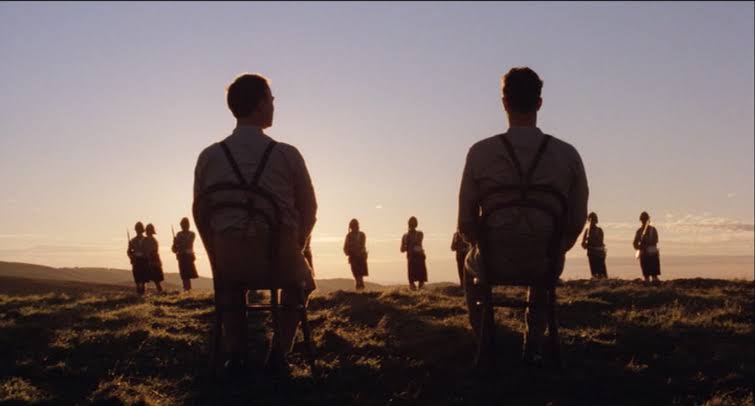In his book Josh Hartnett definitely wants to do this… True stories from a life in the screen trade, Beresford rates Breaker Morant alongside Tender Mercies, Driving Miss Daisy, and Black Robe as his best films. All four are exceptional films (including Daisy: don’t @ me) and I’d add Mister Johnson to that top tier line-up, with many other terrific films in the wings. And yet Beresford remains perennially underrated: not quite the Rodney Dangerfield of Australian filmmakers, but in the pantheon he’s markedly less praised than, say, Peter Weir or George Miller. The currency of the ‘auteur’ remains strong and hip, and his filmography lacks certain qualities associated with auteurism—such as a tangible visual signature and uniformity of tone across his work—though he possesses other auteurist qualities, such as a gallery of regular players (Woodward and Thompson among them) and some thematic preoccupations that recur across films, most notably culture clash, a theme prevalent in Breaker Morant. I recently asked Drew McWeeny, a critic with a particular affinity for 80s cinema—the era of Breaker Morant and Beresford’s American ascent—what he thought of the director on a discussion forum, to which he replied:
I think he’s a solid journeyman … I am a big fan of Australian cinema, and I think Beresford deserves to be spoken about when you talk about how things broke internationally. He has certainly earned that place in the conversation.
The ‘journeyman’ label—as opposed to the more distinguished auteur label—has dogged Beresford for much of his career, though some fairly anonymous fare like Her Alibi and The Contract certainly doesn’t help dispel it. Pauline Kael, a critic fairly cool on the Australian New Wave (with the exception of Fred Schepisi’s films), singled out Beresford for particular criticism in a Cinema Papers interview:
Bruce Beresford is, for me, perhaps one of the most academic of directors. There is a certain gloomy, clumsy fidelity in his work. The sheer lack of imagination is perhaps his greatest weapon.
While Kael labels Beresford’s work ‘academic’ as a slight, I would argue this is a strength in his best films, one especially evidenced in Breaker Morant: an attention to micro detail—such as holding on moments of military ritual—that make the screen world feel authentic and inhabited, and a probing of different vantage points and perspectives that gives the film its thematic texture and rounded characterisation. Those academic qualities—rigour, curiosity, precision, detachment—are also what gives the film’s climax its particular, peculiar frisson. More on that shortly.


Two other strengths of Beresford’s filmmaking are worth highlighting here. Firstly, he’s a great adapter for the screen, with a knack for spotting and intelligently translating and amplifying material for film. He’s a particularly sure hand at adapting stage plays, as evidenced by strong adaptations in Don’s Party, The Club, Driving Miss Daisy, the at times overwrought Crimes of the Heart, and of course Breaker Morant. This film endured a particularly laboured adaptation process, as recounted in Peter Coleman’s book Bruce Beresford: Instincts of the Heart:
He delayed production for six months while he settled the script, rejecting almost entirely one written by Jonathan Hardy and Davis Stevens … as well as Kenneth Ross’s play on which their script was based. These presented the Australians as innocent scapegoats (Beresford believed that whatever else they were, they were also murderers), were too simple-mindedly anti-British and ignored altogether the issue which obsessed Beresford: how decent men will be brutalised by the inescapable imperatives of war … The shooting script is almost entirely Beresford’s but (after a court case) Hardy, Stevens and Ross, the ultimate originators of the treatment, shared the credits.
I can’t speak to Hardy and Stevens’ initial script, but I have read Ross’s play. It’s a solid stage-play, and a handful of the film’s court scenes and several dialogue scenes are derived fairly faithfully from this source, albeit tightened for screen. Moreover, a key ingredient of the film’s much-admired climax, the reciting of Morant’s poem “Butchered to make a Dutchman’s holiday”, is borrowed from the play, albeit Thomas reads it onstage while Morant narrates it on film. And the absence of non-diegetic music in this dialogue-heavy film evokes the feeling of watching a stage play, as does the frequent literal treading of the (wooden floor) boards of the courthouse. However, Beresford’s film is substantially different from Ross’s play, more rounded and textured, and as Coleman notes the director injected the accused with more worldliness, less innocence (bar Witton), and ultimately more resignation. While all three screenwriters were Oscar-nominated for Adapted Screenplay (for adapting Ross’s play, with further material drawn from Kit Denton’s novel The Breaker), Beresford deserves most credit for expanding and enriching the story for the screen.
Secondly, there’s Beresford’s unobtrusive craftsmanship. Unlike abovementioned contemporaries Miller and Weir, Beresford’s aesthetic is straightforward and gentle: the photography and editing in his films—here essayed skilfully by Don McAlpine and William Anderson, both regular collaborators with impressive CVs in both Australian and US film—don’t call attention to themselves. This unobtrusive approach, which I’d argue Beresford cemented with this film—not so much the Barry McKenzie films, Don’s Party or The Getting of Wisdom—gives Breaker Morant a classical, timeless feel. While some moments feel dated, the film overall plays terrifically well forty years after its release, and should play just as well in another forty, a complement that can’t be paid to the majority of forty year old films (or, you know, Cats, a three-month-old film time-stamped by ropey of-the-moment effects and oodles of discernible directorial exertion). Despite its un-showy style, there are still lots of great visual touches in the film. My favourite is when Morant and company discover Hunt’s dead body: we don’t see Hunt’s corpse, which is obscured, but we witness and gradually process the soldiers’ responses as the camera slowly tracks forward, their expressions conjuring atrocities—“They mutilated him with knives while he was still alive”—that are only articulated later in the film.
While Beresford’s un-showy approach means the film plays better today than other Australian films of its era, “What have you done for me lately?” remains a fair question to ask of an older film, in an era where so much brand-spanking new programming and media content competes for our attention. On that point, as I hope I’ve already demonstrated, Breaker Morant remains thematically ripe and resonant in 2020. Morant tells Witton “It’s a new kind of war George. A new war for a new century. I’d say this is the first time the enemy hasn’t been in uniform”. While a historian could probably poke a sizeable hole in this grand claim, Morant’s observation on the Boer War nonetheless foreshadows the Nazi concentration camps and the brutal guerrilla combat between Germans and Soviets on the Eastern front during World War II, along with the major imperial wars of the latter half of the twentieth century—America’s similarly questionable crusades in Vietnam and the Middle East—and the new modes of war in the twenty-first century—terror, biological, technological—which have posed new moral quandaries and relegated images of uniformed men charging at one another to a bygone era. Yet whatever the war, the film’s message, smartly articulated by Thomas in his closing remarks, persists:
War changes men’s natures. The barbarities of war are seldom committed by abnormal men. The tragedy of war is that these horrors are committed by normal men in abnormal situations. Situations in which the ebb and flow of everyday life have departed, and been replaced by a constant round of fear and anger, blood and death. Soldiers at war are not to be judged by civilian rules.
Though set against the Boer War and released in the aftermath of acclaimed Vietnam War films like The Deer Hunter and Apocalypse Now, film historian Robert Sklar (quoted by Coleman) noted that Breaker Morant’s depiction of the toll of war on ostensibly good and normal people—and the institutional complicity in that toll—resonated with a post-Vietnam audience, commenting that:
“To an American audience Breaker Morant can hardly be experienced other than as a commentary on the Vietnam War”.
I’d argue it resonates equally within other cultures. Lest we pay short shrift to the two major World Wars that fell between the Boer War and Vietnam, it’s worth noting, as the film’s closing text highlights, that both Witton and Thomas lived to see both wars, though neither survived to see the latter’s end: Witton, who penned the book Scapegoats of Empire about the court martial, died in August of 1942, Thomas in November that same year. Morant and Handcock were spared those two global wars, but did not see the end of the Boer War.
If you’re angry I’ve spoiled this, I did warn you at the start of this article…
Our graves were dug the day they arrested us at Fort Edward.
Despite Thomas’s “unexpectedly good defence”, the inevitability of Morant’s execution hangs forebodingly over the film: the writing is on the wall for Morant and Handcock from the outset. Thomas responds with anger, calling the court martial “a bloody sham”, but Morant takes the news of his sentence with a dose of British stiff upper lip: “Well Peter, this is what comes of Empire-building”.
While Kael slams what she perceives as a lack of passion in Beresford’s films, the finale of Breaker Morant is striking because it’s precisely that unsympathetic execution of a heightened emotional moment—not unlike the execution seen onscreen—that gives the climax its quiet, gut-punching gravitas. After requesting a pointed epitaph—“And a man’s foes shall be they of his own household” from the Gospel of Matthew 10:36, a final jab at the military elite—Morant and Handcock walk hand in hand into the veld to meet their firing squad. At the end of Gallipoli, released the following year, director Weir set the tragic final moments to Albinoni and Giazotto’s haunting Adagio in G Minor: incredibly poignant, but emotional manipulation of the highest order. Here, Morant and Handcock sit in silence and watch the sun rise over the veld as their executioners prepare, with Morant’s poem “Butchered to make a Dutchman’s holiday” narrated over the scene (credit again to Ross for the creative choice, and to Beresford for assigning the verse to Morant rather than Thomas). The final lines, like Morant’s preferred epitaph, are decidedly pointed.
But we bequeath a parting tip
For sound advice of such men,
Who come across in transport ship
To polish off the Dutchmen!
If you encounter any Boers
You really must not loot them.
And if you want to leave the shores
For pity’s sakes, don’t shoot them.
Morant shouts his last: “Shoot straight you bastards! Don’t make a mess of it”. Guns fire. Bullets strike. Chairs tip. Bodies fall. Thud. The film ends on more military ritual—captured at length, with anthropological luxury and curiosity—as the executioners march away and the corpses are placed into coffins. All this is scored to a song of Empire—“The Soldiers of the Queen”, a final ironic twisting of the knife–sung by Woodward, a multi-hyphenate like his onscreen charge.
Breaker Morant. Still quietly, crushingly devastating at forty years young.
Director: Bruce Beresford
Cast: Edward Woodward, Jack Thompson, Bryan Brown
Writers: Jonathan Hardy, David Stevens, Bruce Beresford, (Based on Breaker Morant: A Play in Two Acts by Kenneth G. Ross, and The Breaker by Kit Denton)




